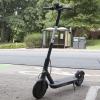City Pages
Athens Streets High in Number of Bike, Pedestrian Crashes
Prince Avenue has the third-highest crash rate in the state for bicyclists, says a Georgia Department of Transportation safety study, and other Athens streets—Baxter, Oconee and Broad—also made the top 20. That could be because Athens has more bicyclists than other places, and since bicyclists aren't registered or counted like cars, no one really knows how many people ride. But most reported crashes are in metro areas, and many involve "angle" crashes with cars making turns. The state's highest bicycle crash rate has been along Ponce de Leon Avenue in Atlanta.
Most Georgia bicyclists don't wear helmets, the report said (Georgia law requires helmets for riders under 16). There are more than a dozen bicyclists killed in Georgia most years, and over 90 percent of fatalities are to riders without helmets. "I don't see a lot of helmet usage in the Athens area," said James Barlament, a researcher in the University of Georgia's College of Public Health who has studied accident data statewide. Barlament's numbers show nearly one bicycle fatality per year in Athens-Clarke County, and an average of about 27 reported accidents with injuries. The foot of Baxter hill (at Lumpkin Street) is a particularly accident-prone location.
More frequent than bicycle accidents are pedestrian accidents—more than 50 a year in ACC, with 16 people killed between 2006 and 2010. Lack of sidewalks contributes to the dangers, Barlament said, and so do "alcohol-impaired" pedestrians. Only 7 percent of Georgia's streets and roads have sidewalks. "There's also an issue with being visible" at night, both for pedestrians and bicyclists. Most pedestrians killed are hit while crossing a street—usually not at a crosswalk—and most die at night, state statistics say.
But better enforcement of seatbelt laws has cut overall traffic fatalities in Georgia, Barlament says—plus motorists are speeding less "because they don't want to use as much gas."
Retired middle school principal Ken Sherman has for years led local group rides, including the annual Athens-to-Savannah bike ride to support local schools. (He'll be leading the Teardrop Metric Century ride in September to support the Interfaith Hospitality Network.) Those rides—and the frequent Nitty Gritty Bike Band rides around Athens—are routed along back roads and low-traffic state highways, Sherman said.
Problems with aggressive drivers have been "exceedingly rare," he said. The two-day Savannah ride attracts some 70 riders, and "they get spread out over many miles." Incidents with drivers have been few; most are patient with bicyclists. "It's more than just tolerating each other—it's good for the whole community," Sherman says—as it has been for Portland, Oregon, where the popularity of bicycling has "helped make it a destination where people want to come and live and set up businesses. It's created a sense of vibrancy and health and energy."












comments